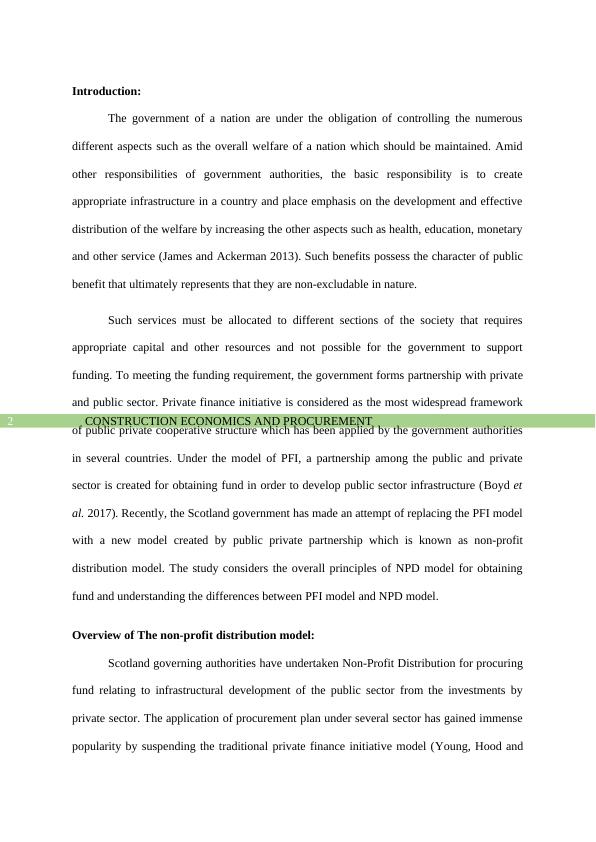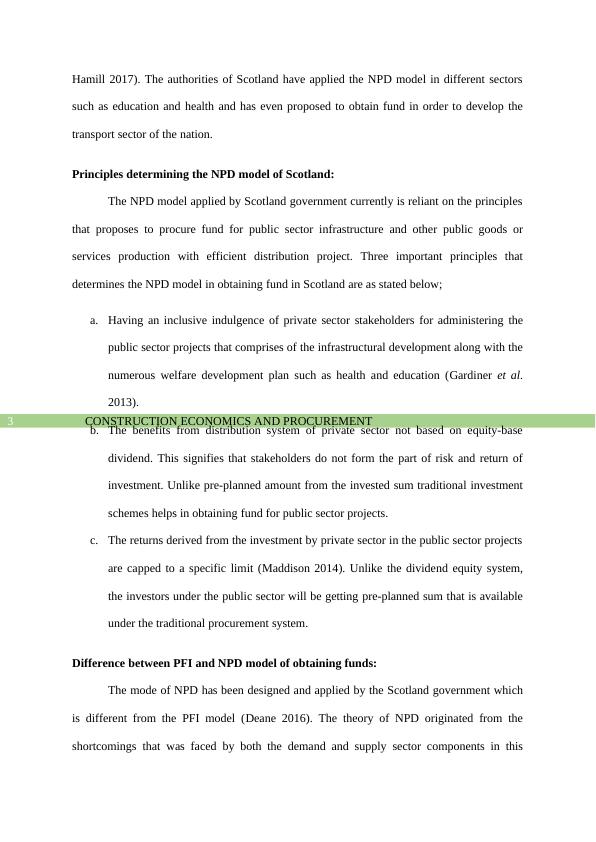Construction Economics and Procurement in Scotland
Added on 2020-04-13
11 Pages2702 Words84 Views
Running head: CONSTRUCTION ECONOMICS AND PROCUREMENT Construction Economics and ProcurementName of the StudentName of the UniversityAuthors NoteCourse ID

CONSTRUCTION ECONOMICS AND PROCUREMENT1Table of ContentsIntroduction:...............................................................................................................................2Overview of The non-profit distribution model:........................................................................2Principles determining the NPD model of Scotland:.................................................................3Difference between PFI and NPD model of obtaining funds:...................................................3Critical assessment of NPD projects: Scotland Construction Industry......................................4Factor contributing to the success of NPD project:...................................................................4Factors resulting in negative implications of NPD model:........................................................6Scopes for enhancing NPD:.......................................................................................................7Conclusion:................................................................................................................................8Reference List:...........................................................................................................................9

CONSTRUCTION ECONOMICS AND PROCUREMENT2Introduction: The government of a nation are under the obligation of controlling the numerousdifferent aspects such as the overall welfare of a nation which should be maintained. Amidother responsibilities of government authorities, the basic responsibility is to createappropriate infrastructure in a country and place emphasis on the development and effectivedistribution of the welfare by increasing the other aspects such as health, education, monetaryand other service (James and Ackerman 2013). Such benefits possess the character of publicbenefit that ultimately represents that they are non-excludable in nature. Such services must be allocated to different sections of the society that requiresappropriate capital and other resources and not possible for the government to supportfunding. To meeting the funding requirement, the government forms partnership with privateand public sector. Private finance initiative is considered as the most widespread frameworkof public private cooperative structure which has been applied by the government authoritiesin several countries. Under the model of PFI, a partnership among the public and privatesector is created for obtaining fund in order to develop public sector infrastructure (Boyd etal. 2017). Recently, the Scotland government has made an attempt of replacing the PFI modelwith a new model created by public private partnership which is known as non-profitdistribution model. The study considers the overall principles of NPD model for obtainingfund and understanding the differences between PFI model and NPD model. Overview of The non-profit distribution model: Scotland governing authorities have undertaken Non-Profit Distribution for procuringfund relating to infrastructural development of the public sector from the investments byprivate sector. The application of procurement plan under several sector has gained immensepopularity by suspending the traditional private finance initiative model (Young, Hood and

CONSTRUCTION ECONOMICS AND PROCUREMENT3Hamill 2017). The authorities of Scotland have applied the NPD model in different sectorssuch as education and health and has even proposed to obtain fund in order to develop thetransport sector of the nation. Principles determining the NPD model of Scotland:The NPD model applied by Scotland government currently is reliant on the principlesthat proposes to procure fund for public sector infrastructure and other public goods orservices production with efficient distribution project. Three important principles thatdetermines the NPD model in obtaining fund in Scotland are as stated below; a.Having an inclusive indulgence of private sector stakeholders for administering thepublic sector projects that comprises of the infrastructural development along with thenumerous welfare development plan such as health and education (Gardiner et al.2013). b.The benefits from distribution system of private sector not based on equity-basedividend. This signifies that stakeholders do not form the part of risk and return ofinvestment. Unlike pre-planned amount from the invested sum traditional investmentschemes helps in obtaining fund for public sector projects. c.The returns derived from the investment by private sector in the public sector projectsare capped to a specific limit (Maddison 2014). Unlike the dividend equity system,the investors under the public sector will be getting pre-planned sum that is availableunder the traditional procurement system. Difference between PFI and NPD model of obtaining funds: The mode of NPD has been designed and applied by the Scotland government whichis different from the PFI model (Deane 2016). The theory of NPD originated from theshortcomings that was faced by both the demand and supply sector components in this

End of preview
Want to access all the pages? Upload your documents or become a member.
Related Documents
Construction Economics and Procurement Assignmentlg...
|11
|2826
|60
Construction Economics Assignmentlg...
|15
|3662
|246
Reasons for Success of the NPD Model Projectslg...
|15
|3525
|103
Procurement & Contractslg...
|6
|811
|176
Private finance initiative (PFI): a case study of Carillion plclg...
|8
|2694
|348
Problems of PFI Report 2022lg...
|8
|1481
|21
